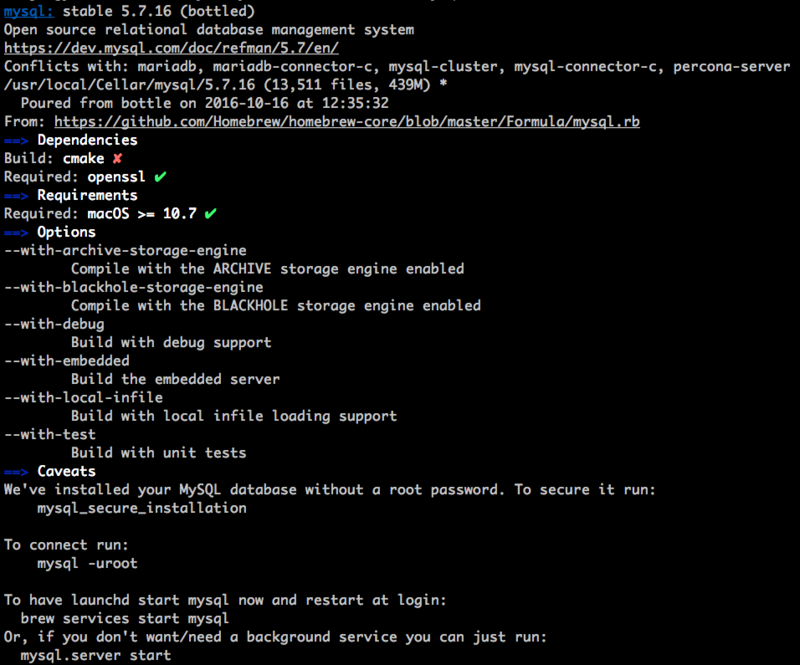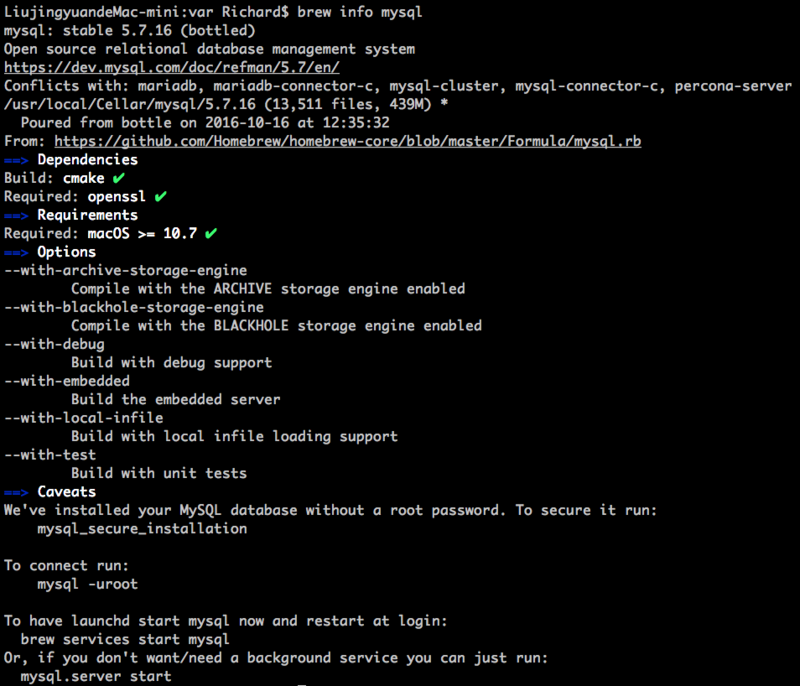Install mysql via brew on Mac
I originally thought that installing and configuring mysql on Mac would be a very simple matter, but I encountered a lot of trouble in the process. It took almost two hours to solve the problem. The purpose of writing this article is to hope that everyone can quickly install and configure mysql on Mac and avoid detours!
How to install mysql on Mac?
Of course you use Homebrew. As for what Homebrew is and how to install Homebrew, please go to the Homebrew official website. After successfully installing Homebrew, run the following command to install mysql:
brew install mysql
After the installation is complete, you can use the following command to view the mysql installation information:
brew info mysql
The detailed installation information is as follows:

You can see a red behind cmake under Dependencies small cross, use the following command to reinstall cmake:
brew unlink cmake brew install cmake
Check the mysql installation information again, and you can find that the red small cross has turned into a green small check, indicating that the dependency problem has been solved:

The problem is here!
When I thought mysql had been installed successfully and used mysql -uroot to connect to the database, the following error occurred:
ERROR 2002 (HY000): Can't connect to local MySQL server through socket '/tmp/mysql.sock' (62)
Check the system cache folder, and there is no mysql.sock file underneath. There are some posts on the Internet that say to find or create my.conf and then modify the path of mysql.sock. I tried it for a long time and found that it didn’t work at all! Then I calmed down and thought about it, and I felt that there was no mysql.sock file in the system cache folder (/tmp). It should be that it was not successfully generated, so why was it not successfully generated? After checking around, I found a post saying that the basic table was not created, so I used mysql_install_db to create the basic table, but the following error occurred:
ERROR! The server quit without updating PID file (/usr/local/var/mysql/xxx.local.pid).
Inexplicably, it said that the PID could not be updated successfully. Where are the files? I browsed the Internet for a long time, and there was a post saying that you can kill the mysql process first, and then do whatever you want. After trying it for a long time, I found that it still didn't work! After suffering for a long time, I finally saw an expert's advice in a reply to a post, saying that I can check the mysql error log. The command to check the mysql error log is as follows:
cat /usr/local/var/mysql/xxx-mini.local.err
You can ignore the [note] and [warning] in the log. It, I directly found [error] which is the error message:

You know what the problem is! It turns out that the lack of read and write permissions caused trouble! Use dscl . list /Users | grep my to find out that the username of mysql in the mac is _mysql, and then modify the owner of the mysql folder:
sudo chown _mysql -R /usr/local/var/mysql/
You’re done! Use sudo mysql.server start to see Starting MySQL .. SUCCESS!, which means that mysql has started normally!

Hot AI Tools

Undresser.AI Undress
AI-powered app for creating realistic nude photos

AI Clothes Remover
Online AI tool for removing clothes from photos.

Undress AI Tool
Undress images for free

Clothoff.io
AI clothes remover

Video Face Swap
Swap faces in any video effortlessly with our completely free AI face swap tool!

Hot Article

Hot Tools

Notepad++7.3.1
Easy-to-use and free code editor

SublimeText3 Chinese version
Chinese version, very easy to use

Zend Studio 13.0.1
Powerful PHP integrated development environment

Dreamweaver CS6
Visual web development tools

SublimeText3 Mac version
God-level code editing software (SublimeText3)

Hot Topics
 MySQL: An Introduction to the World's Most Popular Database
Apr 12, 2025 am 12:18 AM
MySQL: An Introduction to the World's Most Popular Database
Apr 12, 2025 am 12:18 AM
MySQL is an open source relational database management system, mainly used to store and retrieve data quickly and reliably. Its working principle includes client requests, query resolution, execution of queries and return results. Examples of usage include creating tables, inserting and querying data, and advanced features such as JOIN operations. Common errors involve SQL syntax, data types, and permissions, and optimization suggestions include the use of indexes, optimized queries, and partitioning of tables.
 How to connect to the database of apache
Apr 13, 2025 pm 01:03 PM
How to connect to the database of apache
Apr 13, 2025 pm 01:03 PM
Apache connects to a database requires the following steps: Install the database driver. Configure the web.xml file to create a connection pool. Create a JDBC data source and specify the connection settings. Use the JDBC API to access the database from Java code, including getting connections, creating statements, binding parameters, executing queries or updates, and processing results.
 MySQL's Place: Databases and Programming
Apr 13, 2025 am 12:18 AM
MySQL's Place: Databases and Programming
Apr 13, 2025 am 12:18 AM
MySQL's position in databases and programming is very important. It is an open source relational database management system that is widely used in various application scenarios. 1) MySQL provides efficient data storage, organization and retrieval functions, supporting Web, mobile and enterprise-level systems. 2) It uses a client-server architecture, supports multiple storage engines and index optimization. 3) Basic usages include creating tables and inserting data, and advanced usages involve multi-table JOINs and complex queries. 4) Frequently asked questions such as SQL syntax errors and performance issues can be debugged through the EXPLAIN command and slow query log. 5) Performance optimization methods include rational use of indexes, optimized query and use of caches. Best practices include using transactions and PreparedStatemen
 Why Use MySQL? Benefits and Advantages
Apr 12, 2025 am 12:17 AM
Why Use MySQL? Benefits and Advantages
Apr 12, 2025 am 12:17 AM
MySQL is chosen for its performance, reliability, ease of use, and community support. 1.MySQL provides efficient data storage and retrieval functions, supporting multiple data types and advanced query operations. 2. Adopt client-server architecture and multiple storage engines to support transaction and query optimization. 3. Easy to use, supports a variety of operating systems and programming languages. 4. Have strong community support and provide rich resources and solutions.
 MySQL's Role: Databases in Web Applications
Apr 17, 2025 am 12:23 AM
MySQL's Role: Databases in Web Applications
Apr 17, 2025 am 12:23 AM
The main role of MySQL in web applications is to store and manage data. 1.MySQL efficiently processes user information, product catalogs, transaction records and other data. 2. Through SQL query, developers can extract information from the database to generate dynamic content. 3.MySQL works based on the client-server model to ensure acceptable query speed.
 How to start mysql by docker
Apr 15, 2025 pm 12:09 PM
How to start mysql by docker
Apr 15, 2025 pm 12:09 PM
The process of starting MySQL in Docker consists of the following steps: Pull the MySQL image to create and start the container, set the root user password, and map the port verification connection Create the database and the user grants all permissions to the database
 Laravel Introduction Example
Apr 18, 2025 pm 12:45 PM
Laravel Introduction Example
Apr 18, 2025 pm 12:45 PM
Laravel is a PHP framework for easy building of web applications. It provides a range of powerful features including: Installation: Install the Laravel CLI globally with Composer and create applications in the project directory. Routing: Define the relationship between the URL and the handler in routes/web.php. View: Create a view in resources/views to render the application's interface. Database Integration: Provides out-of-the-box integration with databases such as MySQL and uses migration to create and modify tables. Model and Controller: The model represents the database entity and the controller processes HTTP requests.
 How to install mysql in centos7
Apr 14, 2025 pm 08:30 PM
How to install mysql in centos7
Apr 14, 2025 pm 08:30 PM
The key to installing MySQL elegantly is to add the official MySQL repository. The specific steps are as follows: Download the MySQL official GPG key to prevent phishing attacks. Add MySQL repository file: rpm -Uvh https://dev.mysql.com/get/mysql80-community-release-el7-3.noarch.rpm Update yum repository cache: yum update installation MySQL: yum install mysql-server startup MySQL service: systemctl start mysqld set up booting






